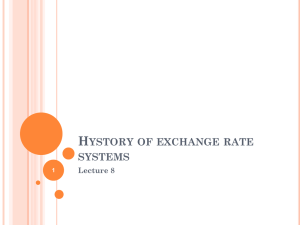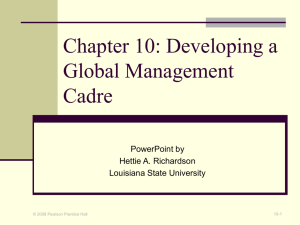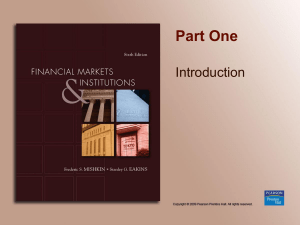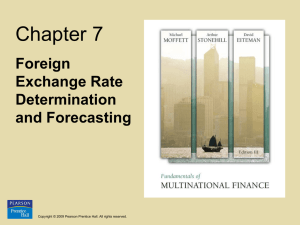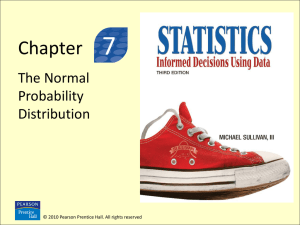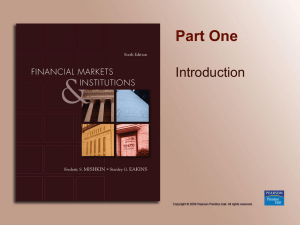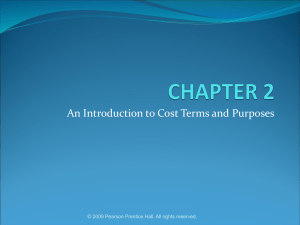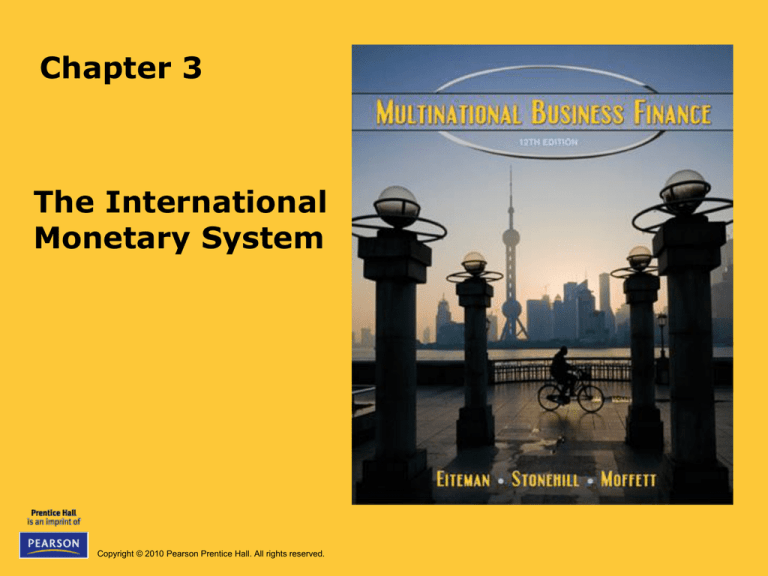
Chapter 3
The International
Monetary System
Copyright © 2010 Pearson Prentice Hall. All rights reserved.
History of the International
Monetary System
• The Gold Standard (1876 – 1913)
– Gold has been a medium of exchange since 3000 BC
– “Rules of the game” were simple, each country set the
rate at which its currency unit could be converted to a
weight of gold
– Currency exchange rates were in effect “fixed”
– Expansionary monetary policy was limited to a
government’s supply of gold
– Was in effect until the outbreak of WWI as the free
movement of gold was interrupted
Copyright © 2010 Pearson Prentice Hall. All rights reserved.
3-2
History of the International
Monetary System
• The Inter-War Years & WWII (1914-1944)
– During this period, currencies were allowed to fluctuate
over a fairly wide range in terms of gold and each other
– Increasing fluctuations in currency values became
realized as speculators sold short weak currencies
– The US adopted a modified gold standard in 1934
– During WWII and its chaotic aftermath the US dollar was
the only major trading currency that continued to be
convertible
Copyright © 2010 Pearson Prentice Hall. All rights reserved.
3-3
History of the International
Monetary System
• Bretton Woods and the International
Monetary Fund (IMF) (1944)
– As WWII drew to a close, the Allied Powers met
at Bretton Woods, New Hampshire to create a
post-war international monetary system
– The Bretton Woods Agreement established a US
dollar based international monetary system and
created two new institutions the International
Monetary Fund (IMF) and the World Bank
Copyright © 2010 Pearson Prentice Hall. All rights reserved.
3-4
History of the International
Monetary System
– The International Monetary Fund is a key
institution in the new international monetary
system and was created to:
• Help countries defend their currencies against cyclical,
seasonal, or random occurrences
• Assist countries having structural trade problems if
they promise to take adequate steps to correct these
problems
– The International Bank for Reconstruction and
Development (World Bank) helped fund postwar reconstruction and has since then
supported general economic development
Copyright © 2010 Pearson Prentice Hall. All rights reserved.
3-5
History of the International
Monetary System
• Eurocurrencies
– These are domestic currencies of one country
on deposit in a second country
– The Eurocurrency markets serve two valuable
purposes:
• Eurocurrency deposits are an efficient and convenient
money market device for holding excess corporate
liquidity
• The Eurocurrency market is a major source of shortterm bank loans to finance corporate working capital
needs (including export and import financing)
Copyright © 2010 Pearson Prentice Hall. All rights reserved.
3-6
History of the International
Monetary System
• Eurocurrency Interest Rates: Libor
– In the Eurocurrency market, the reference rate
of interest is the London Interbank Offered Rate
(LIBOR)
– This rate is the most widely accepted rate of
interest used in standardized quotations, loan
agreements, and financial derivatives
transactions
Copyright © 2010 Pearson Prentice Hall. All rights reserved.
3-7
Exhibit 3.1 U.S. Dollar-Denominated
Interest Rates, June 2005
Copyright © 2010 Pearson Prentice Hall. All rights reserved.
3-8
History of the International
Monetary System
• Fixed Exchange Rates (1945-1973)
– The currency arrangement negotiated at Bretton Woods and
monitored by the IMF worked fairly well during the post-WWII
era of reconstruction and growth in world trade
– However, widely diverging monetary and fiscal policies,
differential rates of inflation and various currency shocks
resulted in the system’s demise
– The US dollar became the main reserve currency held by central
banks, resulting in a consistent and growing balance of
payments deficit which required a heavy capital outflow of
dollars to finance these deficits and meet the growing demand
for dollars from investors and businesses
Copyright © 2010 Pearson Prentice Hall. All rights reserved.
3-9
History of the International
Monetary System
– Eventually, the heavy overhang of dollars held by foreigners
resulted in a lack of confidence in the ability of the US to met its
commitment to convert dollars to gold
– The lack of confidence forced President Richard Nixon to
suspend official purchases or sales of gold by the US Treasury
on August 15, 1971
– This resulted in subsequent devaluations of the dollar
– Most currencies were allowed to float to levels determined by
market forces as of March, 1973
Copyright © 2010 Pearson Prentice Hall. All rights reserved.
3-10
History of the International
Monetary System
• An Eclectic Currency Arrangement (1973 –
Present)
– Since March 1973, exchange rates have become
much more volatile and less predictable than
they were during the “fixed” period
– There have been numerous, significant world
currency events over the past 30 years
Copyright © 2010 Pearson Prentice Hall. All rights reserved.
3-11
Exhibit 3.2 The IMF’s Nominal Exchange
Rate Index of the U.S. Dollar and
Significant Events 1957-2008
Copyright © 2010 Pearson Prentice Hall. All rights reserved.
3-12
The IMF’s Exchange Rate
Regime Classifications
• The International Monetary Fund classifies all
exchange rate regimes into eight specific
categories
–
–
–
–
–
–
–
–
Exchange arrangements with no separate legal tender
Currency board arrangements
Other conventional fixed peg arrangements
Pegged exchange rates within horizontal bands
Crawling pegs
Exchange rates within crawling pegs
Managed floating with no pre-announced path
Independent floating
Copyright © 2010 Pearson Prentice Hall. All rights reserved.
3-13
Fixed Versus Flexible
Exchange Rates
• A nation’s choice as to which currency regime to
follow reflects national priorities about all facets
of the economy, including:
–
–
–
–
–
inflation,
unemployment,
interest rate levels,
trade balances, and
economic growth.
• The choice between fixed and flexible rates may
change over time as priorities change.
Copyright © 2010 Pearson Prentice Hall. All rights reserved.
3-14
Fixed Versus Flexible
Exchange Rates
• Countries would prefer a fixed rate regime
for the following reasons:
– stability in international prices
– inherent anti-inflationary nature of fixed prices
• However, a fixed rate regime has the
following problems:
– Need for central banks to maintain large
quantities of hard currencies and gold to defend
the fixed rate
– Fixed rates can be maintained at rates that are
inconsistent with economic fundamentals
Copyright © 2010 Pearson Prentice Hall. All rights reserved.
3-15
Attributes of the “Ideal” Currency
• Possesses three attributes, often referred
to as the Impossible Trinity:
– Exchange rate stability
– Full financial integration
– Monetary independence
• The forces of economics to not allow the
simultaneous achievement of all three
Copyright © 2010 Pearson Prentice Hall. All rights reserved.
3-16
Exhibit 3.4 The Impossible Trinity
Copyright © 2010 Pearson Prentice Hall. All rights reserved.
3-17
Emerging Markets
and Regime Choices
• A currency board exists when a country’s central bank
commits to back its monetary base – its money supply –
entirely with foreign reserves at all times.
• This means that a unit of domestic currency cannot be
introduced into the economy without an additional unit of
foreign exchange reserves being obtained first.
– Argentina moved from a managed exchange rate to a
currency board in 1991
– In 2002, the country ended the currency board as a result
of substantial economic and political turmoil
Copyright © 2010 Pearson Prentice Hall. All rights reserved.
3-18
Emerging Markets
and Regime Choices
• Dollarization is the use of the US dollar as
the official currency of the country.
• One attraction of dollarization is that sound
monetary and exchange-rate policies no
longer depend on the intelligence and
discipline of domestic policymakers.
– Panama has used the dollar as its official
currency since 1907
– Ecuador replaced its domestic currency with the
US dollar in September, 2000
Copyright © 2010 Pearson Prentice Hall. All rights reserved.
3-19
The Euro:
Birth of a European Currency
• In December 1991, the members of the
European Union met at Maastricht, the
Netherlands to finalize a treaty that
changed Europe’s currency future.
• This treaty set out a timetable and a plan
to replace all individual ECU currencies with
a single currency called the euro.
Copyright © 2010 Pearson Prentice Hall. All rights reserved.
3-20
The Euro:
Birth of a European Currency
• To prepare for the EMU, a convergence criteria
was laid out whereby each member country was
responsible for managing the following to a
specific level:
–
–
–
–
Nominal inflation rates
Long-term interest rates
Fiscal deficits
Government debt
• In addition, a strong central bank, called the
European Central Bank (ECB), was established in
Frankfurt, Germany.
Copyright © 2010 Pearson Prentice Hall. All rights reserved.
3-21
Effects of the Euro
• The euro affects markets in three ways:
– Cheaper transactions costs in the Euro Zone
– Currency risks and costs related to uncertainty
are reduced
– All consumers and businesses both inside and
outside the Euro Zone enjoy price transparency
and increased price-based competition
Copyright © 2010 Pearson Prentice Hall. All rights reserved.
3-22
Achieving Monetary Unification
• If the euro is to be successful, it must have
a solid economic foundation.
• The primary driver of a currency’s value is
its ability to maintain its purchasing power.
• The single largest threat to maintaining
purchasing power is inflation, so the job of
the EU has been to prevent inflationary
forces from undermining the euro.
Copyright © 2010 Pearson Prentice Hall. All rights reserved.
3-23
Exchange Rate Regimes:
The Future
• All exchange rate regimes must deal with the tradeoff
between rules and discretion (vertical), as well as between
cooperation and independence (horizontal) (see exhibit 2.8)
• The pre WWI Gold Standard required adherence to rules and
allowed independence
• The Bretton Woods agreement (and to a certain extent the
EMS) also required adherence to rules in addition to
cooperation
• The present system is characterized by no rules, with
varying degrees of cooperation
• Many believe that a new international monetary system
could succeed only if it combined cooperation among nations
with individual discretion to pursue domestic social,
economic, and financial goals
Copyright © 2010 Pearson Prentice Hall. All rights reserved.
3-24
Exhibit 3.8 The Trade-offs between
Exchange Rate Regimes
Copyright © 2010 Pearson Prentice Hall. All rights reserved.
3-25
Mini-Case Questions: The Revaluation of
the Chinese Yuan
• Many Chinese critics had urged China to
revalue the yuan by 20% or more. What
would the Chinese yuan’s value be in US
dollars if it had indeed been devalued by
20%?
• Do you believe that the revaluation of the
Chinese yean was politically or
economically motivated?
Copyright © 2010 Pearson Prentice Hall. All rights reserved.
3-26
Mini-Case Questions: The Revaluation of
the Chinese Yuan (cont’d)
• If the Chinese yuan were to change by the
maximum allowed per day, 0.3% against the US
dollar, consistently over a 30 or 60 day period,
what extreme values might it reach?
• Chinese multinationals would now be facing the
same exchange rate-related risks borne by US,
Japanese, and European multinationals. What
impact do you believe this rising risk will have on
the strategy and operations of Chinese companies
in the near-future?
Copyright © 2010 Pearson Prentice Hall. All rights reserved.
3-27
Chapter 3
Additional
Chapter Exhibits
Copyright © 2010 Pearson Prentice Hall. All rights reserved.
Exhibit 3.3
World
Currency
Events,
1971–2008
Copyright © 2010 Pearson Prentice Hall. All rights reserved.
3-29
Exhibit 3.3
World
Currency
Events,
1971–2008
(cont.)
Copyright © 2010 Pearson Prentice Hall. All rights reserved.
3-30
Exhibit 3.5 The Ecuadorian Sucre
Exchange Rate, November 1998–March
2000
Copyright © 2010 Pearson Prentice Hall. All rights reserved.
3-31
Exhibit 3.6 The Currency Regime
Choices for Emerging Markets
Copyright © 2010 Pearson Prentice Hall. All rights reserved.
3-32
Exhibit 3.7 The U.S. Dollar/Euro Spot
Exchange Rate, 1999–2008 (Monthly
Average)
Copyright © 2010 Pearson Prentice Hall. All rights reserved.
3-33
Exhibit 1 Monthly Average
Exchange Rates: Chinese Renminbi
per U.S. Dollar
Copyright © 2010 Pearson Prentice Hall. All rights reserved.
3-34


